|
|
|
Sort Order |
|
|
|
Items / Page
|
|
|
|
|
|
|
| Srl | Item |
| 1 |
ID:
157399
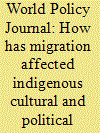

|
|
|
|
|
| Summary/Abstract |
Picture the American city. You can see it and so can I: gleaming post-industrial buildings, businesspeople in suits, working-class people toiling in service jobs, de-industrialization galore. Now, picture Native Americans. Not as illustrations in history books, but alive on reservations, maybe even leading protests, out of sight but somewhere in the American hinterland. These images don’t fit together very well. For many, they are juxtaposed: The former represents the pinnacle of progress, the latter the periphery and past. Yet according to the Census Bureau seven in 10 Native Americans, or 3.7 million people, live in cities. Even among the budding Indigenous intelligentsia, there is often a disconnect between our everyday realities and the way we place and tell our stories.
|
|
|
|
|
|
|
|
|
|
|
|
|
|
|
|
| 2 |
ID:
132313
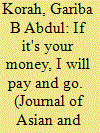

|
|
|
|
|
| Publication |
2014.
|
| Summary/Abstract |
Like many ethnic groups in sub-Saharan Africa, the Dagaaba of northwest (now Upper West region) Ghana have regarded, and for the most part, continue to regard the payment of the brideprice as the cornerstone upon which marriage is built - without it a marriage contract is not considered legal. Since the 1980s, however, the significance or essence of the payment has been contested and challenged by many Dagaaba. While some (young men) argue for a reform of the payment, others (young women) argue that the practice should be abolished altogether. Yet a third group (mostly elders) believes that brideprice payment is a "tradition" passed down over generations that should be maintained. This article examines the origins and historical significance of brideprice payments, and how views about these payments have changed over time among the Dagaaba - from those born near the close of the last century, to those of marriageable age now. The goal of this examination is to contribute to the ongoing discussion among African scholars and governments on the importance of maintaining certain aspects of their cultural heritage.
|
|
|
|
|
|
|
|
|
|
|
|
|
|
|
|
| 3 |
ID:
105287
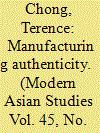

|
|
|
|
|
| Publication |
2011.
|
| Summary/Abstract |
According to Prasenjit Duara, the sacredness of the nation hinges on its 'regimes of authenticity' where timelessness and the politics of embodiment are key to an authentic national identity. This paper looks at three different cultural impulses that have attempted to manufacture authenticity in Singapore. They are: the Malay literary movement Angkatan Sasterawan 50 prior to independence; the state-sponsored Confucian ethics discourse during the 1980s; and the romanticization of the working-class 'heartlander' through contemporary popular culture in confrontation with the politics of global capitalism and globalization. In doing so, this paper articulates the difference between the regimes of authenticity of state elites and non-state cultural producers, as well as their 'national imaginaries'. It concludes that the regime of authenticity, that operationalizes the representations of the working class as a diametric opposite to the logic and force of globalization, offers the most popular symbols of national identity in Singapore.
|
|
|
|
|
|
|
|
|
|
|
|
|
|
|
|
| 4 |
ID:
138938
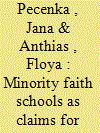

|
|
|
|
|
| Summary/Abstract |
This paper presents two cases of minority faith school claim-making in England and considers what supporters of the claims say about their hopes and intentions for the schools. The paper redresses a gap in the literature on minority faith school claims and on minority claim-making more generally, which has tended to present minority claims as expressions of specific religious group identities, whilst it has had little to say about what motivates individual claimants to mobilise in the name of such identities. From an in-depth study of individual positions in favour of the two faith schools, it is concluded that depicting these claims as primarily claims for identity recognition fails to attend to the multilayered ways in which these claimants discuss their orientations to the claims and the root causes they identify for making them.
|
|
|
|
|
|
|
|
|
|
|
|
|
|
|
|
| 5 |
ID:
132734
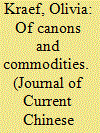

|
|
|
|
|
| Publication |
2014.
|
| Summary/Abstract |
The Nuosu are a subgroup of the so-called Yi ethnic group. Today around two million Nuosu live in Liangshan Autonomous Prefecture in Sichuan Province and translocal urban contexts, such as Chengdu and Beijing. For many centuries, the Nuosu have cultivated a belief system composed of a combination of animism and ancestor worship. Since the resurrection of religious activity across China that began in the early 1980s, this faith - represented by the three types of religious practitioners known as bimo, sunyi, and monyi - has reportedly been experiencing a comprehensive revival at folk level. For the bimo, this revival has been paralleled and increasingly overlaid by a scholarly reappraisal of Nuosu religion under premises other than religious. Bimo practice and identity have thus become subsumed under the illustrious concept of "bimo culture". In this article, I trace the genealogy of the concept of "bimo culture" as part of a cultural canon of and for the Yi which is intended to promote development at the local level but which is also contributing to a weakening of the status of the bimo and Nuosu ritual life in Liangshan today.
|
|
|
|
|
|
|
|
|
|
|
|
|
|
|
|
| 6 |
ID:
132269
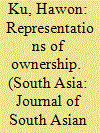

|
|
|
|
|
| Publication |
2014.
|
| Summary/Abstract |
This article explains the changes found in patas (cloth paintings) depicting Shatrunjaya, which were produced for Shvetambara Murtipujak Jains during the nineteenth century in Gujarat. These patas differed from earlier tirtha patas in that they were much larger and depicted Shatrunjaya as the central subject matter. They were also meticulous in depicting the topographical and architectural features of the site, and included Palitana, the adjacent town ruled by the Hindu Thakur. The emergence of the site as a centre for Jain pilgrimage, as well as changes in Jain perceptions of the site, led to these transformations
|
|
|
|
|
|
|
|
|
|
|
|
|
|
|
|
| 7 |
ID:
168460
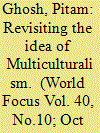

|
|
|
|
|
| Summary/Abstract |
The idea of multiculturalism in contemporary political discourse and in political philosophy is about how to understand and respond to the challenges associated with cultural and religious diversity. The term “multicultural” is often used as a descriptive term to characterize the fact of diversity in a society, but in what follows, the focus is on its prescriptive use in the context of Western liberal democratic societies.
|
|
|
|
|
|
|
|
|
|
|
|
|
|
|
|
| 8 |
ID:
131905
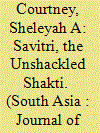

|
|
|
|
|
| Publication |
2014.
|
| Summary/Abstract |
In Hindu cosmology and life-worlds, women are described as being Shaktis, personifications of cosmic feminine power or shakti. However, the shakti of Hindu widows of all ages, because it is no longer directed into reproduction, is feared as being rampant, likely to incur disgrace, polluting and dangerous. Hence, widows, deemed culpable of having failed in their primary wifely duty of protecting and preserving the health and lives of their husbands, are often ill-treated in an attempt to weaken and disarm the reservoir of power that they continue to embody. This article focuses on a case study of a young widow, Savitri, who strove to support her children and maintain her self-regard in the face of frequently-violent hostility from her neighbours due to her creative yet subversive circumvention of the religio-cultural prescriptions and proscriptions her widow status demanded. The article explores social and psychological processes through which identification with the great Hindu goddess, Mahadevi, might enable marginalised widows to sustain the self-experience of being imbued with power-shakti-like their goddess is, albeit within the constraints of the wider community.
|
|
|
|
|
|
|
|
|
|
|
|
|
|
|
|
|
|
|
|
|